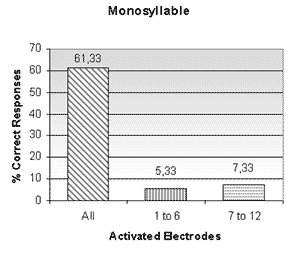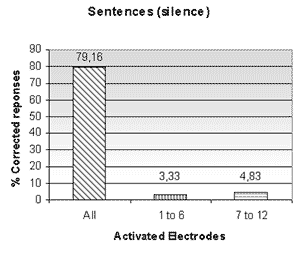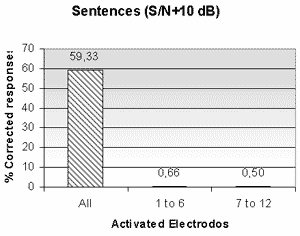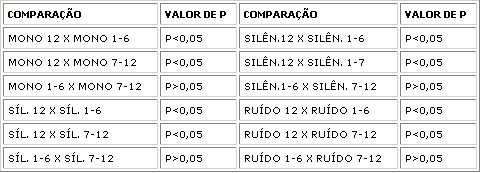

Year: 2003 Vol. 69 Ed. 3 - (12º)
Artigo Original
Pages: 364 to 369
Effects of number and position of electrodes in the cochlea on speech perception of implanted patients post-lingually deafened
Author(s):
Flávia M. de L. Rizzi[1],
Maria C. Bevilacqua[2]
Keywords: speech; electrodes-cochlea.
Abstract:
Introduction: Patients implanted with the same model of cochlear implant obtain different degree of benefit depending on the programming of the system. Objective: Considering that an specific channel of the internal device stimulates aproximately the same area of the scala tympani in patients who have full electrode insertion, the aim of this study was to evaluate if there is an specific area responsible for a better performance in speech perception skills. Study Design: clinical prospective. Material and Method: 12 postlingually profundly deaf individual participated in this study, all of them were patients of the cochlear implant program of the Audiological Research Center- HRAC- University of São Paulo, and users of the Med-El multichannel system with full insertion of the electrodes. The performance of the speech perception tests were compared across the following conditions: 1) all channels activated; 2) 6 most basal channels activated and 3) 6 most apical channels activated. Results: Statistically significant differences were found between the conditions 1 and 2 and between the conditions 1 and 3, but no statistically significant differences were found between the conditions 2 and 3. Conclusion: The findings did not allow a direct confrontation between a cochlear specific area with a better performance in the speech perception, however, 7 out of 12 patients tested had better results when the 6 basal channels were activated, suggesting that in case of partial insertions, when the electrical stimulation occour in the basal and medial regions of the cochlea, there could be benefit derived from auditory information.
![]()
INTRODUCTION
Profound sensorineural hearing loss is characterized by damage to the hair cells that lead to pure tone auditory thresholds that are elevated and highly impaired speech perception 1.
The effects of using a hearing aid in subjects with profound sensorineural hearing loss have been extensively studied showing that to most cases, little auditory information is used owing to the cochlear damage presented by them 2.
In past years, the benefits of the use of multichannel cochlear implants (CI), especially concerning speech perception, proved to be a highly efficient resource promoting results better than those found in regular use of hearing aids 3-6.
Electrical stimulation promoted by the system of CI transmits the signal from the auditory nerve fibers directly to the brain 7, since subjects with profound sensorineural hearing loss have significant decrease in hair cells, which causes a separation between the peripheral and central auditory systems.
The system of multichannel cochlear implant consists of external components (microphone, speech processor and transmission antenna) and internal components (receptive-stimulating unit and a bundle of electrodes). The system operates in fractions of seconds. The environmental sounds are collected by the behind-the-ear directional microphone and sent, through cables, to the speech processor that filters, analyzes, digitizes and converts the input sound into codified signs. The signs are sent, though the cable, to a speech processor to the transmitting antenna that sends them transcutaneously to the receptor-stimulating unit by radio frequency. The receptor-stimulator has an integrate unit that converts the codes into electronic signs and send them to the electrode bundle inserted in the cochlea. The electrodes, in turn, stimulate the remaining nervous fibers and the resulting neural fibers follow the central nervous system up to the auditory brain centers where signs are interpreted and produce the hearing sensation 8, 9.
The different ways that exist for the stimulation to occur are called electrode stimulation mode and can be bipolar, in which the electrical stimulation occurs in between two electrodes located a short distance from the cochlear; monopolar, in which the flow is generated between the intracochlear (active) electrode and the extracellular one (reference) that acts as the ground electrode to them all; and the common-ground in which a single intracochlear electrode is designated as active and the others are connected in order to form a single indifferent electrode, resulting in diffuse tidal flow 8-10.
The way through which the speech processor converts the input sound captured by the microphone in electrical signals is named speech codification strategy 8. The various strategies that were developed to multichannel implants can be divided into three groups: digital, analog and hybrid, according to the characteristics of the codification of the electrical signal. The SPEAK strategy uses band filters that produce monopolar stimulation with short duration pulses. This system provides high speech stimulation. The CIS strategy conventionally enables the stimulation of few channels at high and flat speed, offering detailed information and preserving the signal amplitude range. ACE strategy is a set of hybrid codes, developed to match the advantages of the SPEAK strategy (high-speed stimulation , better representation of frequencies) with the advantages of CIS (high-speed stimulation and better temporal resolution )11.
Great variability of benefits can be found in patients users of the multichannel CI system. This variability can be explained by the difference in residues of ganglionar cells or existing neural elements, surgical insertion of device on the tympanic scala, survival of the central neural structures, in addition to the way in which the system is programmed to each user 12. Another aspect that should be considered is the variation in number of activated electrodes in the cochlea.
Multichannel devices provide electrical stimulation in various cochlear sites, using the electrode bundle. Different electrodes are stimulated, depending on the frequency of the input signal: electrodes close to the cochlear base are stimulated with high frequency signals and electrodes close to the apex are stimulated with low frequency signals 18. The number of electrodes can be defined as quantity of electrical contacts inserted in the cochlea, representing the contacts of positive and negative polarity through which there is electrical current, and the number of channels, such as the number of independent filters of signal information, which are released in parallel to the inner ear. The channel represents the stimulation site 8. There are individual stimulation parameters to each patient that can be reprogrammed whenever necessary. We call it the "map" of each programming. Problems with the external components can be easily solved by replacing them, however, problems with internal components are more difficult to solve. The recommendation of manufacturers is that problems associated with the electrode bundle can be solved with changes to the map programming, eliminating specific electrodes that are causing the problems.
Many conditions may cause the need to deactivate one or more electrodes. Sometimes during surgical excision, an electrode can be damaged or even not inserted owing to cochlear ossification (partial insertion of electrode bundle). Other electrodes, upon electrical stimulation, can stimulate the facial nerve causing sore throat, sore eyes and pain 13. Vertigo and poor sound quality complaints are also common. In such cases, the problematic electrodes can be excluded from the map. The remaining issue is at what extend there is a damage to speech perception as a result of such deactivations and if there is a cochlear region (basal or apical) responsible for the best performance of such skills.
In order to check the effects of different electrode programs on speech perception, five users of system IC Nucleus 22 (Cochlear) were assessed in various positions of the map: 1) the 5 most apical electrodes were excluded; 2) the 5 most basal electrodes were removed; 3) 6 medial electrodes were eliminated; and 4) map used by the patient (all electrodes were activated). Three subjects had worse performance in situation one and two subjects were well placed in all positions, with no statistically significant differences. All subjects preferred their own maps (situation 4) concerning sound quality 14.
In another situation, in order to study speech recognition related to the number of electrodes used in programs including strategy SPEAK, speech perception tests were applied in 11 patients with 1, 2, 4, 7, 10 and 20 activated electrodes. They all presented poor scores with 1 activated electrode and the mean performance increased a lot when the number of electrodes went from 1 to 4. No statistically significant differences were observed with 4 to 20 on elements. These data suggest that users are not capable of using the whole spectral information provided by the implant when the 20 electrodes are activated. 12
The correlation between speech perception and depth of insertion of the electrode bundle in the cochlea was studied and it was concluded that based on 327 patients, that the greater the insertion, and consequently the greater the number of active electrodes, the better the speech recognition index 15. Another study simulated the effect of partial insertion of electrodes in speech compression. Speech perception tests were carried out using a frequency filter device that simulated the partial insertion in 9 hearing subjects, with stimulation of the cochlear base up to 22 to 25 mm of insertion towards the apex. In the situation of partial insertion simulation, the performance was worse than without stimulation, indicating that the reduced number of electrodes in the cochlea can interfere significantly in speech perception of CI users 16.
The present study intended to assess speech perception skills according to number and location of activated electrodes and check if there is a cochlear region (base or apex) that provides better performance for speech perception skills.
MATERIAL AND METHOD
The study comprised 12 subjects with post-lingual profound bilateral sensorineural hearing loss in the CI Program of Centro de Pesquisas Audiológicas (CPA), Hospital de Reabilitação de Anomalias Craniofaciais (HRAC-USP). The study was approved by the Ethics Committee of HRAC-USP and all patients were instructed about the procedures and signed the informed consent term.
All subjects were users of multichannel CI Med-EL, with internal component Combi 40+ and processor Tempo + (behind-the-ear) or CIS PRO (conventional) and presented total insertion of electrodes in the cochlea and open set speech recognition. The stimulation mode used was monopolar and the speech signal codification strategy was CIS.
Ages ranged from 8 years and 2 months to 69 years and 8 months and deafness duration before CI surgery ranged from 5 months to 8 years and 4 months. The trial period with the CI ranged from 3 months to 24 months.
We conducted speech perception tests in three different situations: 1) all activated channels; 2) only 6 channels of the cochlear base were activated; and 3) only 6 electrodes of the apical region were activated. It is important to highlight that programs containing deactivated electrodes were used only during the test.
Description of the speech perception tests:
We used the open set protocol with meaningless syllables, monosyllables and daily sentences recognition tests.
- Meaningless syllable recognition: we used lists that contained VCV (vowel-consonant-vowel) formats proposed by the Consonant Confusion Study - Confusion Program presented in the software of the system IC NUCLEUS in its programming unit version 6.90. Each list contained 19 stimuli and beginning and ending with vowel /a/.
- Recognition of monosyllables: we used repetition lists with 25 monosyllables 17, presented in free field at 60 dB and sound source located at 0o azimuth of the implanted ear.
- Sentence recognition: we used the sentences lists of CPA 18. They were presented in situations of quite and noise (S/N ratio +10 dB). The noise used was competitive noise "cocktail party". Speech signals were presented in free field at 60 dB with the sound source positioned at 0o azimuth from the implanted ear.
For the application of the list of meaningless syllables and monosyllables we used a speech material developed by HRAC and the School of Speech and Language Pathology and Audiology Bauru/USP, recorded in two CDs that were reproduced by the device CD player Teac PD-P30- Compact Disc Digital Audio coupled to the CD output of the audiometer Midimate 622- Madsen Electronics.
For the list of sentence, we used cassette tapes brand BASF, model FEI extra iron 60", recorded in the study of Radio UNESP/Bauru (University Júlio de Mesquita Filho), by a male voice narrator. The reproduction of the material was made using device brand Pioneer, model CT W103 # Stereo Double Cassette Deck, connected to the tape output of the audiometer.
The procedures above mentioned were conducted in a 2m x 2m sound proof booth.
A micro computer Pentium II with Intel processor, brand Hewlett Packard, with 32.0 MB RAMB, connected to programming interface DIB (Diagnostic Interface Box) and the processor software for programming CIS PRO, CIS PRO+ and TEMPO+ were used to adjust the system (deactivation of electrodes) used by patients that participated in the study.
Data statistical analyses were conducted using Friedman and Dunn tests to compare results of speech perception tests in different proposed situations 19.
RESULTS
The results of the speech perception tests used in the present study can be observed in Graphs 1, 2, 3, and 4 and Table 1.Graph 1. Percentage of correct responses relative to number and position of the activated channels by applying a monosyllable list.Graph 2. Percentage of correct responses relative to number and position of activated channels by applying a meaningless syllable list.Graph 3. Percentage of correct responses relative to number and position of activated channels by applying a list of sentences in silence.Graph 4. Percentage of correct responses relative to number and position of activated channels by applying a list of sentences in noise.Table 1. Dunn Test 19: P values compared to test situations.WHERE:
MONO: monosyllable repetition test;
SIL: meaningless syllable repetition test;
SILEN.: sentence test in silence;
NOISE: sentence test in noise;
12: all activated channels;
1-6: 6 all apical channels are activated, and
7-12: 6 basal channels are activated.
NOTE: there is statistically significant difference when P<0.05.
DISCUSSION
Upon employing Friedman and Dunn tests for the statistical analysis 19 of collected data, we detected a statistically significant difference between situations 1 (all channels activated) and 2 (only channels 1 to 6 were activated) and between situations 1 and 3 (only channels 7 to 12 were activated) (p<0.05); however, there was no difference for the comparison of situations 2 and 3 (p>0.05). We also observed that patients with little experience with the CI (up to 6 months of use) presented better performance with 6 basal channels, whereas 4 of the 5 patients who had used it for over 1 years and 6 months presented better results when the 6 apical electrodes were activated.
The results showed that eliminating 6 channels of the cochlea base or 6 channels of the apical region result in harmful effect over speech perception. Despite the fact there was no statistically significant difference between the groups in such conditions, there was a difference among the involved groups. Five had better speech recognition index with 6 apical channels activated and seven with the 6 basal channels activated, differently from results previously reported in the literature 14, in which three out of five subjects had worse results in situations in which the 5 most apical electrodes were deactivated.
Similarly to previous studies 15, 16, the present study showed that a minimum number of activated electrodes is required for good speech perception.
After the application of tests, all patients preferred the situation of all activated channels to have better sound quality, in agreement with the results of previous studies 14.
CONCLUSION
There was a significant worsening in speech recognition index comparing situation 1 (all activated channels) and those obtained in the other two situations, but data collected did not allow to refer to the cochlear region that had the best performance in speech perception skills, since there was no statistically significant difference between situation 2 (only 6 basal channels activated) and 3 (only 6 apical channels activated).
We should reinforce that differences were observed when we conducted inter-subject comparisons, showing that most patients improved the results in the tests when the electrodes of the basal cochlear region were activated. Such data are important because they suggest that partial insertions, in which electrodes do not reach the apical region of the cochlea and the stimulation is more intensely directed to the medial and basal regions, there is better use of auditory information.
REFERENCES
1. Katz J. Tratado de audiologia clínica. 4th ed. São Paulo: Manole; 1999.
2. Ferrari DV. Aparelhos de amplificação sonora individuais: caracterização e utilização em adultos com deficiência auditiva neurossensorial [dissertação]. São Paulo: Pontifícia Universidade Católica de São Paulo; 1999.
3. Clark GM, Cowan RSC, Dowell RC. Cochlear implantation for infants and children advances. San Diego: Singular; 1997.
4. Nikolopoulos TP, O'Donoghue GM, Archbold S. Age at implantation: its importance in pediatric cochlear implantation. Laryngoscope 1999; 109:595-9.
5. Pfingst BE, Holloway LA, Zwolan TA, Collins LM. Effects of stimulus level on electrode-place discrimination in human subjects with cochlear implants. Hear Res 1999;134:105-15.
6. Van Dijik JE, Van Olphen AF, Langereis MC, Mens LH, Brokx JP, Smooremburg GF. Predictors of cochlear implant performance. Audiology 1999;38:109-16.
7. Wilson BS. Cochlear implant technology. In: Niparko JK, Kirk KI, Mellon NK, Robbins AM, Tucci DL, Wilson BS. Cochlear implants: principles & practices. Philadelphia: Lippincott Williams, Wilkins; 2000. p.109-27.
8. Bevilacqua MC. Implante coclear multicanal: uma alternativa na habilitação de crianças surdas [tese]. Bauru: Faculdade de Odontologia de Bauru, Universidade de São Paulo; 1998.
9. Costa Filho OA. Implantes cocleares multicanais no tratamento da surdez em adultos [tese]. Bauru: Faculdade de Odontologia de Bauru, Universidade de São Paulo; 1998.
10. Loizou PC. Introduction to cochlear implants. IEEE Eng Med Biol Mag 1999;18:32-42.
11. Loizou PC. Signal-processing techniques for cochlear implants: a review of progress in deriving electrical stimuli from the speech signal. IEEE Eng Med Biol Mag 1999; 18:34-46.
12. Fishman KE, Shannon RV, Slattery WH. Speech recognition as a function of the number of electrodes used in the SPEAK cochlear implant speech processor. J Speech Lang Hear Res 1997;40:1201-15.
13. Cohen NL, Waltzman SB, Shapiro WH. Telephone speech comprehension with use of the Nucleus Cochlear Implant. Ann Otol Rhinol Laryngol Suppl 1989;142:8-11.
14. Geier LL, Norton SJ. The effects of limiting the number of Nucleus 22 cochlear implant electrodes programmed on speech perception. Ear Hear 1992;13:340-8.
15. Hartrampf R, Dahm MC, Battmer RD, Gnadeberg D, Strauss-Schier A, Rost U et al. Insertion depth of the Nucleus electrode array and relative performance. Ann Otol Rhinol Laryngol Suppl 1995;166:277-80.
16. Dorman MF, Loizou PC, Rainey D. Simulating the effect of cochlear implant electrode insertion depth on speech understanding. J Acoust Soc Am 1997;102:2993-6.
17. Lacerda AP. Audiologia clínica. Rio de Janeiro: Guanabara Koogan; 1976.
18. Valente SLOL. Elaboração de listas de sentenças [dissertação]. São Paulo: Pontifícia Universidade Católica; 1998.
19. Zar JH. Biostatistical analysis. 3rd. ed. New Jersey: Prentice Hall; 1996.
1 - Speech Therapist and Audiologist, Specialized in Audiology, Hospital de Reabilitação de Anomalias Craniofaciais da Universidade de São Paulo (HRAC-USP), Bauru, SP.
2 - Full Professor, Department of Speech and Language Pathology and Audiology, School of Dental Sciences of Bauru, University of São Paulo; Audiologist, Centro de Pesquisas Audiológicas do Hospital de Reabilitação de Anomalias Craniofaciais da Universidade de São Paulo (HRAC-USP), Bauru, SP.
Hospital de Reabilitação de Anomalias Craniofaciais da Universidade de São Paulo (HRAC-USP).
Address correspondence to: Flávia Muniz de Lima Rizzi - R. Nicolau Coutinho 71 Centro 37130-000 Alfenas MG - Tel (55 35) 3291-3016 - E-mail: fmlrizzi@yahoo.com.br




